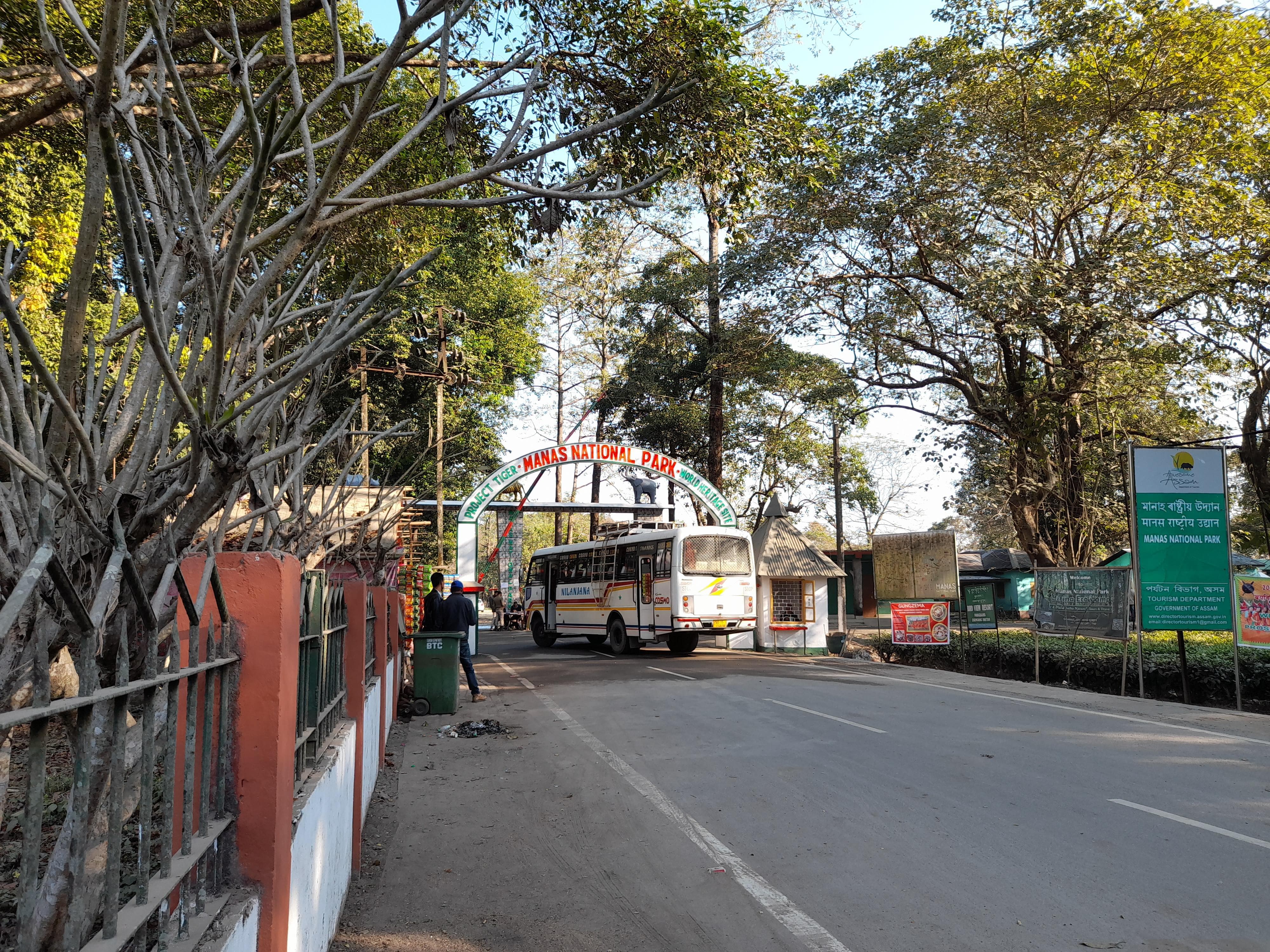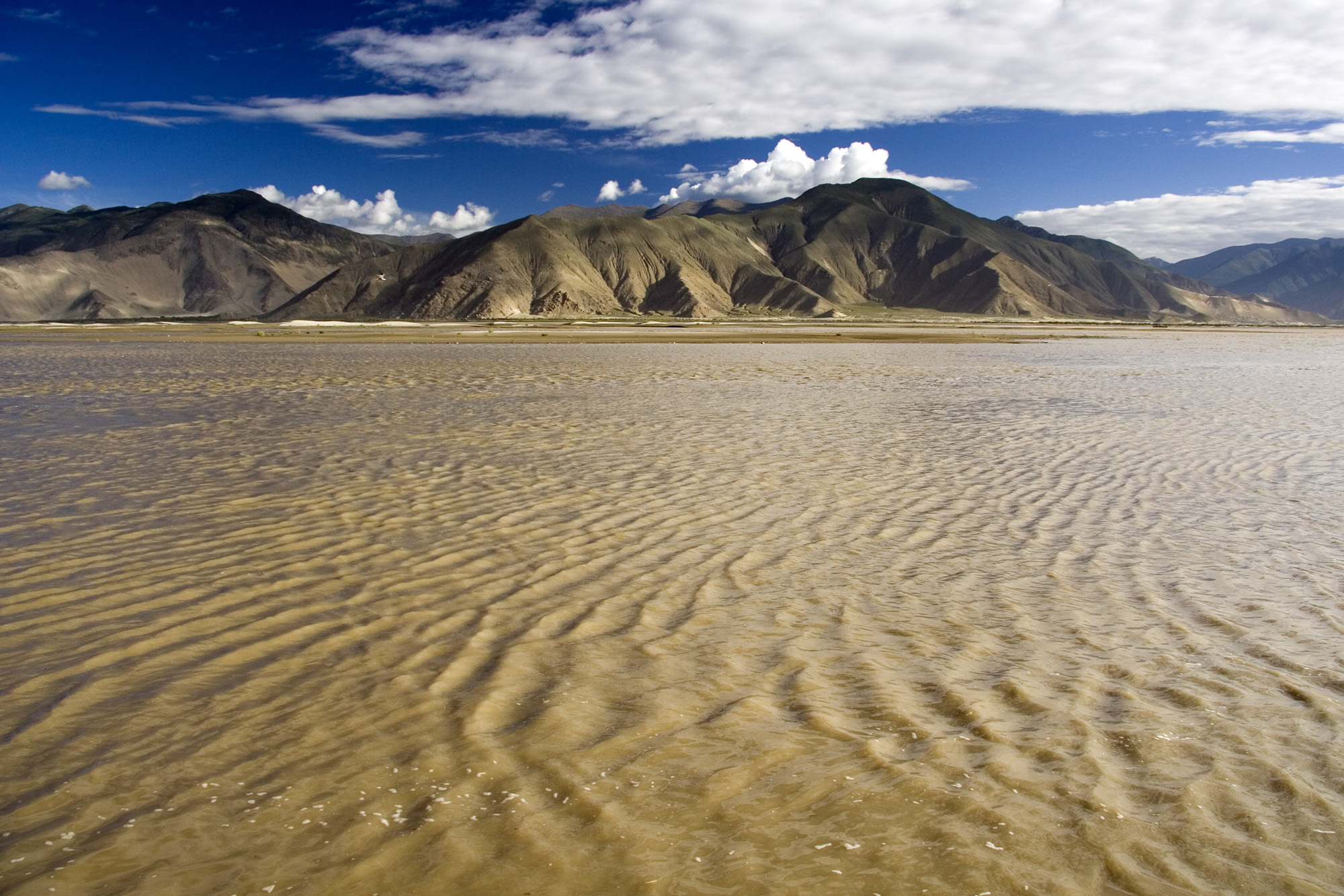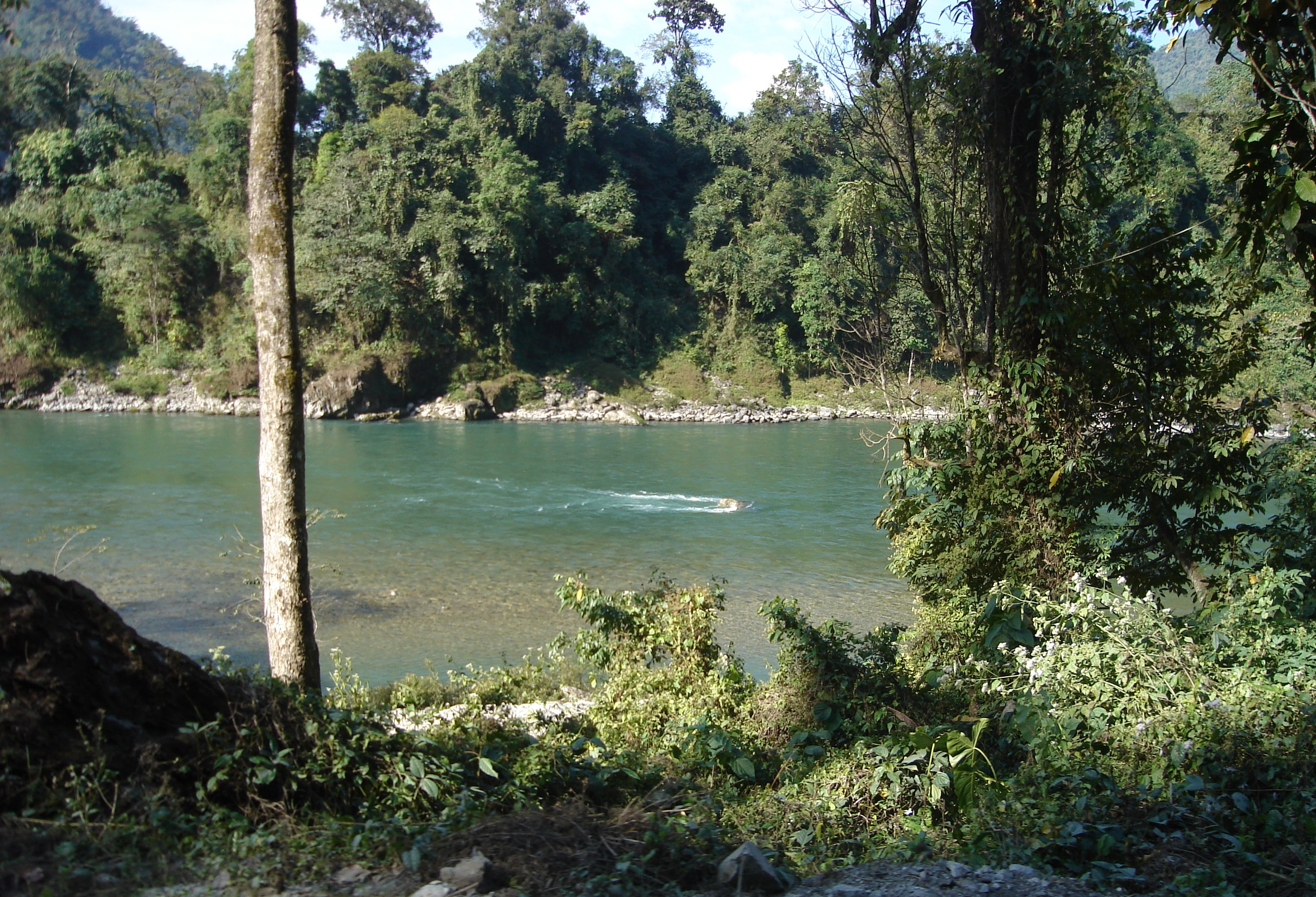|
Manas Wildlife Sanctuary
Manas National Park is a national park, Project Tiger reserve, and an elephant reserve in Assam, India. Located in the Himalayan foothills, it borders the Royal Manas National Park in Bhutan. The park is known for its rare and endangered endemic wildlife such as the Assam roofed turtle, hispid hare, golden langur and pygmy hog. It also hosts the only known population of pygmy hogs in the world. Manas is also famous for its population of the wild water buffalo. Because of its exceptional biodiversity, scenery, and variety of habitats, Manas National Park is a biosphere reserve and a UNESCO World Heritage Site. Origin of the name The name of the park is originated from the Manas River. The Manas river is a major tributary of Brahmaputra River, which passes through the heart of the national park. History The area today consisting of the Manas National Park was under the Kingdom of Bhutan till the Duar War of 1865 when it was ceded to British India. The Manas Wildlife ... [...More Info...] [...Related Items...] OR: [Wikipedia] [Google] [Baidu] |
Chirang District
Chirang District is an administrative Districts of Assam, district in the Bodoland Territorial Region of Assam state in the North-East India, North-East of India. Etymology The word "Chirang" has derived from Garo language, Garo word – "chi" means water and "rang" means "rain". It may also be a copy of Tsirang District of neighbouring Bhutan. On the other hand, most of the people regarded the word Chirang is derived from the Bodo word Chirang or Sirang. Si means life and Rang means Money. History Duars Chirang district falls under the Dooars#Eastern Dooars, Eastern Duars which includes the region between the Sankosh river and the Manas river. Guma, Bijni and Chirang Dooars are three important Dooars in Chirang district. Under the Kingdom of Bhutan From early 17th-century present-day Chirang district was under the control of Kingdom of Bhutan, till the Duar Wars in 1865 when British Raj, British removed the Bhutanese influence and later the areas were merged to undivided Goa ... [...More Info...] [...Related Items...] OR: [Wikipedia] [Google] [Baidu] |
Assam Roofed Turtle
The Assam roofed turtle or Sylhet roofed turtle (''Pangshura sylhetensis'') is a turtle species of the family Geoemydidae found in the Brahmaputra-Meghna drainage in India (Assam) and parts of eastern Bangladesh. It was formerly placed in the genus ''Batagur'' and the defunct genus '' Kachuga''. Description The species has a triangular and elevated carapace with a prominent spiked keel and 26 strongly serrated marginal plates. The carapace is olive brown, with a lighter (yellowish to beige) keel. The head is small and has a weakly hooked upper jaw; a narrow pink stripe runs from the back of each eye to the middle of the back of the head. Adults may attain a maximum length of 20.5 cm, although body sizes of 16 cm are more common. The species' local names include ''dura kaso'' (দূৰা কাছ) in Assamese, ''kãṭa kachim'' (কাঁটা কাছিম) in Bengali. Distribution and habitat The species occurs in the north-eastern and south-eastern parts of ... [...More Info...] [...Related Items...] OR: [Wikipedia] [Google] [Baidu] |
British India
The provinces of India, earlier presidencies of British India and still earlier, presidency towns, were the administrative divisions of British governance in South Asia. Collectively, they have been called British India. In one form or another, they existed between 1612 and 1947, conventionally divided into three historical periods: *Between 1612 and 1757, the East India Company set up "factories" (trading posts) in several locations, mostly in coastal India, with the consent of the Mughal emperors, Maratha Empire or local rulers. Its rivals were the merchant trading companies of Portugal, Denmark, the Netherlands, and France. By the mid-18th century three ''Presidency towns'': Madras, Bombay and Calcutta, had grown in size. *During the period of Company rule in India, 1757–1858, the Company gradually acquired sovereignty over large parts of India, now called "Presidencies". However, it also increasingly came under British government oversight, in effect sharing sovereig ... [...More Info...] [...Related Items...] OR: [Wikipedia] [Google] [Baidu] |
Duar War
The Duar War (or Anglo-Bhutanese War) was a war fought between British India and Bhutan in 1864 to 1865. It has been the only military conflict between the two states since 1774. Background Across the nineteenth century, British India commissioned multiple missions to Bhutan. Official documents always cited cross-border raids by Bhutan or sheltering of dissidents as the immediate cause; however, modern historians note Britain's imperialist ambitions in the region to be the actual pretext. Not only was Bhutan a vital cog in the Indo-Tibetan trade but also the commercial viability of Duars region for supporting tea plantations was well known among Company officials. The most significant of these was a "peace mission" under Ashley Eden in 1863–64, which was dispatched in the wake of a civil war. However, Bhutan rejected the offer and Eden claimed to have been mistreated. The dzongpon of Punakha – who had emerged victorious – had broken with the central government and s ... [...More Info...] [...Related Items...] OR: [Wikipedia] [Google] [Baidu] |
Kingdom Of Bhutan
Bhutan, officially the Kingdom of Bhutan, is a landlocked country in South Asia, in the Eastern Himalayas between China to the north and northwest and India to the south and southeast. With a population of over 727,145 and a territory of , Bhutan ranks List of countries and dependencies by area, 133rd in land area and List of countries and dependencies by population, 160th in population. Bhutan is a Democracy, democratic constitutional monarchy with a King of Bhutan, King as the head of state and a Prime Minister of Bhutan, prime minister as the head of government. The Je Khenpo is the head of the state religion, Vajrayana Buddhism. The Himalayas, Himalayan mountains in the north rise from the country's lush subtropical plains in the south. In the Mountains of Bhutan, Bhutanese Himalayas, there are peaks higher than above sea level. Gangkhar Puensum is Bhutan's highest peak and is the highest unclimbed mountain in the world. The wildlife of Bhutan is notable for its diversi ... [...More Info...] [...Related Items...] OR: [Wikipedia] [Google] [Baidu] |
Southern Border Of Bhutan1985
Southern may refer to: Businesses * China Southern Airlines, airline based in Guangzhou, China * Southern Airways, defunct US airline * Southern Air, air cargo transportation company based in Norwalk, Connecticut, US * Southern Airways Express, Memphis-based passenger air transportation company, serving eight cities in the US * Southern Company, US electricity corporation * Southern Music (now Peermusic), US record label * Southern Railway (other), various railways * Southern Records, independent British record label * Southern Studios, recording studio in London, England * Southern Television, defunct UK television company * Southern (Govia Thameslink Railway), brand used for some train services in Southern England Media * 88.3 Southern FM, a non-commercial community radio station based in Melbourne, Australia * Heart Sussex, a radio station in Sussex, England, previously known as "Southern FM" * ''Nanfang Daily'' or ''Southern Daily'', the official Communist Party ... [...More Info...] [...Related Items...] OR: [Wikipedia] [Google] [Baidu] |
Brahmaputra River
The Brahmaputra is a trans-boundary river which flows through Southwestern China, Northeastern India, and Bangladesh. It is known as Brahmaputra or Luit in Assamese language, Assamese, Yarlung Tsangpo in Lhasa Tibetan, Tibetan, the Siang/Dihang River in Arunachal languages, Arunachali, and Jamuna River (Bangladesh), Jamuna River in Bengali language, Bengali. By itself, it is the 9th List of rivers by discharge, largest river in the world by discharge, and the 15th List of rivers by length, longest. It originates in the Manasarovar Lake region, near Mount Kailash, on the northern side of the Himalayas in Burang County of Tibet Autonomous Region, Tibet where it is known as the Yarlung Tsangpo River. The Brahmaputra flows along southern Tibet to break through the Himalayas in great gorges (including the Yarlung Tsangpo Grand Canyon) and into Arunachal Pradesh. It enters India near the village of Gelling, Arunachal Pradesh, Gelling in Arunachal Pradesh and flows southwest through t ... [...More Info...] [...Related Items...] OR: [Wikipedia] [Google] [Baidu] |
Manas River
The Manas River (pron: �mʌnəs, known in Bhutan as the Drangme Chhu, is a transboundary river in the Himalayan foothills between southern Bhutan, India, and China. It is the largest of Bhutan's four major river systems, with the other three being the Amo Chu or Torsa River, the Wang Chu or Raidak, and the Puna Tshang Chu or Sankosh. It is met by three other major streams before it again debouches into India in western Assam. The river flows for a total length of , including through Tibet for , Bhutan for , and Assam for before it joins the mighty Brahmaputra River at Jogighopa. A major tributary of the Manas, the Aie River, joins it in Assam at Bangpari. The Manas river valley has two major forest reserves, namely Royal Manas National Park (, established in 1966) in Bhutan and the contiguous Manas Wildlife Sanctuary (established at in 1955 and increased to in December 1985), encompassing a Project Tiger reserve, an elephant reserve and a biosphere reserve, which con ... [...More Info...] [...Related Items...] OR: [Wikipedia] [Google] [Baidu] |
World Heritage Site
World Heritage Sites are landmarks and areas with legal protection under an treaty, international treaty administered by UNESCO for having cultural, historical, or scientific significance. The sites are judged to contain "cultural and natural heritage around the world considered to be of outstanding value to humanity". To be selected, a World Heritage Site is nominated by its host country and determined by the UNESCO's World Heritage Committee to be a unique landmark which is geographically and historically identifiable, having a special cultural or physical significance, and to be under a sufficient system of legal protection. World Heritage Sites might be ancient ruins or historical structures, buildings, cities, deserts, forests, islands, lakes, monuments, mountains or wilderness areas, and others. A World Heritage Site may signify a remarkable accomplishment of humankind and serve as evidence of humanity's intellectual history on the planet, or it might be a place of grea ... [...More Info...] [...Related Items...] OR: [Wikipedia] [Google] [Baidu] |
Biosphere Reserve
A nature reserve (also known as a wildlife refuge, wildlife sanctuary, biosphere reserve or bioreserve, natural or nature preserve, or nature conservation area) is a protected area of importance for flora, fauna, funga, or features of geological or other special interest, which is reserved and managed for purposes of Conservation (ethic), conservation and to provide special opportunities for study or research. They may be designated by government institutions in some countries, or by private landowners, such as charities and research institutions. Nature reserves fall into different IUCN protected area categories, IUCN categories depending on the level of protection afforded by local laws. Normally it is more strictly protected than a nature park. Various jurisdictions may use other terminology, such as ecological protection area or private protected area in legislation and in official titles of the reserves. History Cultural practices that roughly equate to the establishmen ... [...More Info...] [...Related Items...] OR: [Wikipedia] [Google] [Baidu] |
Wild Water Buffalo
The wild water buffalo (''Bubalus arnee''), also called Asian buffalo, Asiatic buffalo and wild buffalo, is a large bovine native to the Indian subcontinent and Southeast Asia. It has been listed as ''Endangered'' in the IUCN Red List since 1986, as the remaining population totals less than 4,000. A population decline of at least 50% over the last three generations (24–30 years) is projected to continue. The global population has been estimated at 3,400 individuals, of which 95% live in India, mostly in Assam. The wild water buffalo is the most likely ancestor of the domestic water buffalo. Taxonomy ''Bos arnee'' was the scientific name proposed by Robert Kerr in 1792 who described a skull with horns of a buffalo zoological specimen from Bengal in northern India. The specific name ''arnee'' is derived from Hindi ''arnī'', which referred to a female wild water buffalo; the term is related to Sanskrit ''áraṇya'' ("forest") and ''áraṇa'' ("strange, foreign.") ''Bubalus ... [...More Info...] [...Related Items...] OR: [Wikipedia] [Google] [Baidu] |
Pygmy Hog
The pygmy hog (''Porcula salvania'') is a very small and endangered species of pig and the only species in the genus ''Porcula''. Endemic to India, the pygmy hog is a suid native of the alluvial grasslands in the foothills of the Himalayas, at elevations of up to . Populations of pygmy hogs were once widespread in the tall, dense, wet grasslands in a narrow belt of the southern Himalayan foothills from north-western Uttar Pradesh to Assam, through southern Nepal and North Bengal, and possibly extending into contiguous habitats in southern Bhutan. Due to human encroachment and destruction of the pygmy hogs’ natural habitat, the species was thought to have gone extinct in the early 1960s. However, in 1971, a small pygmy hog population was rediscovered as they were fleeing a fire near the Barnadi Wildlife Sanctuary in Assam. Today, the only known population of pygmy hogs resides in Manas National Park in Assam, India. The population is threatened by livestock grazing, fires and po ... [...More Info...] [...Related Items...] OR: [Wikipedia] [Google] [Baidu] |










